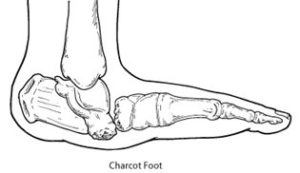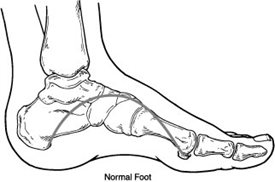What is Charcot Foot?
Charcot foot is a condition causing weakening of the bones in the foot that can occur in people who have significant nerve damage (neuropathy). The bones are weakened enough to fracture, and with continued walking, the foot eventually changes shape. As the disorder progresses, the joints collapse and the foot takes on an abnormal shape, such as a rocker-bottom appearance. Charcot foot is a serious condition that can lead to severe deformity, disability, and even amputation. Because of its seriousness, it is important that patients living with diabetes—a disease often associated with neuropathy—take preventive measures and seek immediate care if signs or symptoms appear.


Causes
Charcot foot develops as a result of neuropathy, which decreases sensation and the ability to feel temperature, pain, or trauma. Because of diminished sensation, the patient may continue to walk—making the injury worse. People with neuropathy (especially those who have had it for a long time) are at risk for developing Charcot foot. In addition, neuropathic patients with a tight Achilles tendon have been shown to have a tendency to develop Charcot foot.
Acute Charcot foot many times is undetected because there are no visible signs; however, changes to the bones of your feet occur as a result of a change in your nerves and blood vessels. When the bones change, even minor trauma can result in small fractures.
Chronic Charcot foot results when those micro-fractures occur over and over without being stabilized. It can lead to deformities in which shoes may not fit and can result in pressure points that may lead to ulcers and infection if not treated.
Symptoms
The symptoms of Charcot foot may include:
- Warmth to the touch (the affected foot feels warmer than the other)
- Redness in the foot
- Swelling in the area
- Pain or soreness
